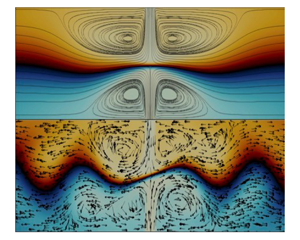Article contents
Impinging planar jets: hysteretic behaviour and origin of the self-sustained oscillations
Published online by Cambridge University Press: 03 March 2021
Abstract

The experimental and numerical investigation presented by Bertsch et al. (Phys. Rev. Fluids, vol. 5, 2020a, p. 054202) describes the self-sustained oscillations induced by the interaction of two impinging jets in microfluidic devices. While the oscillatory regime induced by interacting jets has been studied in detail, the physical mechanism behind these oscillations remains still undetermined. The present paper focuses on two-dimensional oscillators subjected to a fully developed inlet flow, as in Bertsch et al. (Phys. Rev. Fluids, vol. 5, 2020a, p. 054202) and in contradistinction with Pawlowski et al. (J. Fluid Mech., vol. 551, 2006, pp. 117–139), who focused on plug inlet flow. The linear global stability analysis performed confirms the existence of an oscillating global mode, whose spatial structure qualitatively coincides with that computed numerically by Bertsch et al. (Phys. Rev. Fluids, vol. 5, 2020a, p. 054202), suggesting that the physical mechanism from which the oscillations would originate is predominantly two-dimensional. The interaction of the oscillating mode with a steady symmetry-breaking mode is examined making use of the weakly nonlinear theory, which shows how the system exhibits hysteresis in a certain range of aspect ratios. Lastly, sensitivity analysis is exploited to identify the wavemaker associated with the global modes, whose examination allows us to spot the core of the symmetry-breaking instability at the stagnation point and to identify the Kelvin–Helmholtz instability, located in the jets interaction region, as the main candidate for the origin of the oscillations observed in fluidic devices.
- Type
- JFM Papers
- Information
- Copyright
- © The Author(s), 2021. Published by Cambridge University Press
References
REFERENCES
- 10
- Cited by



